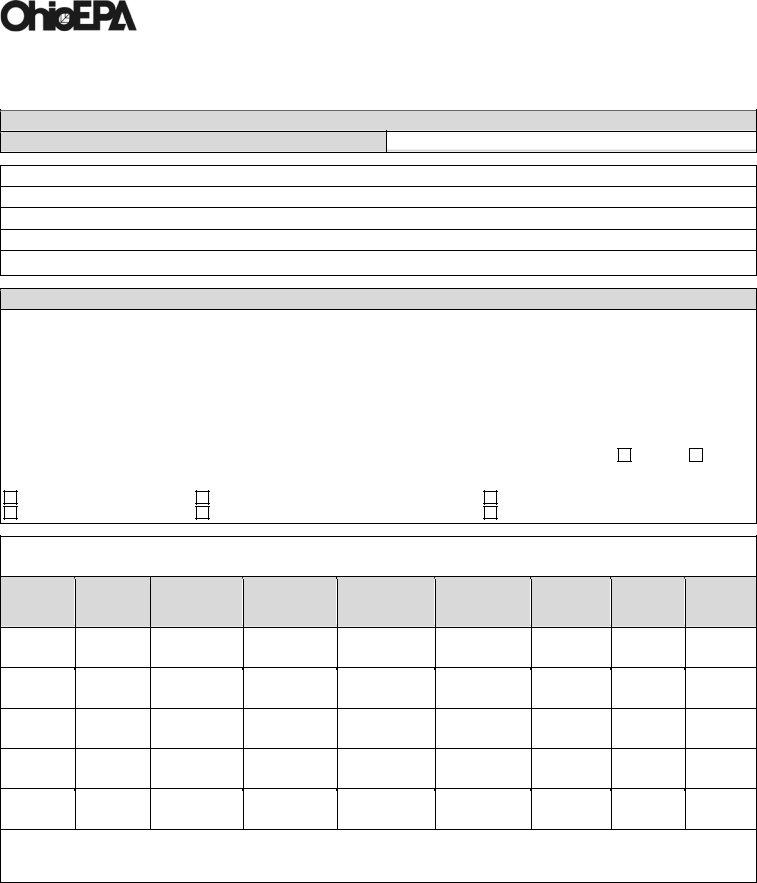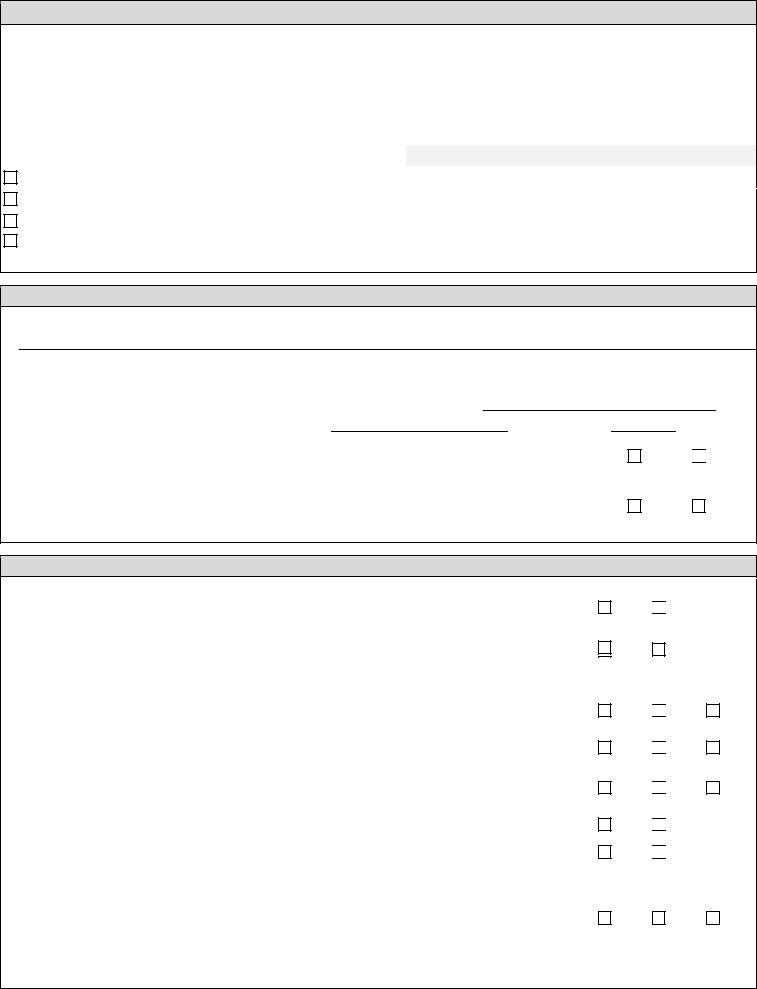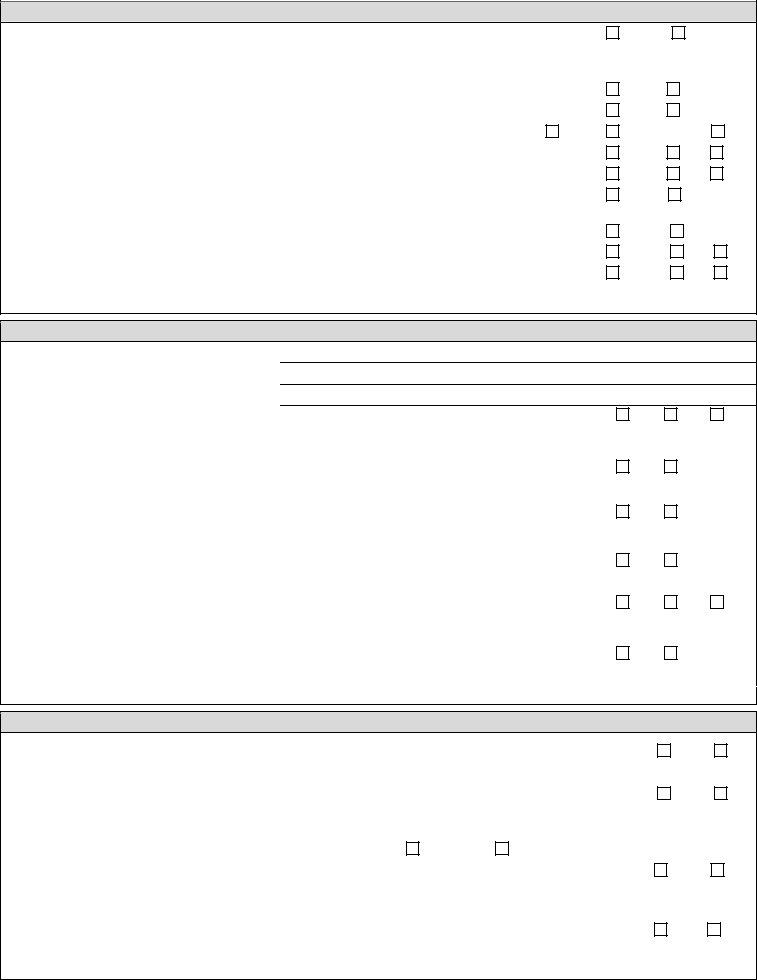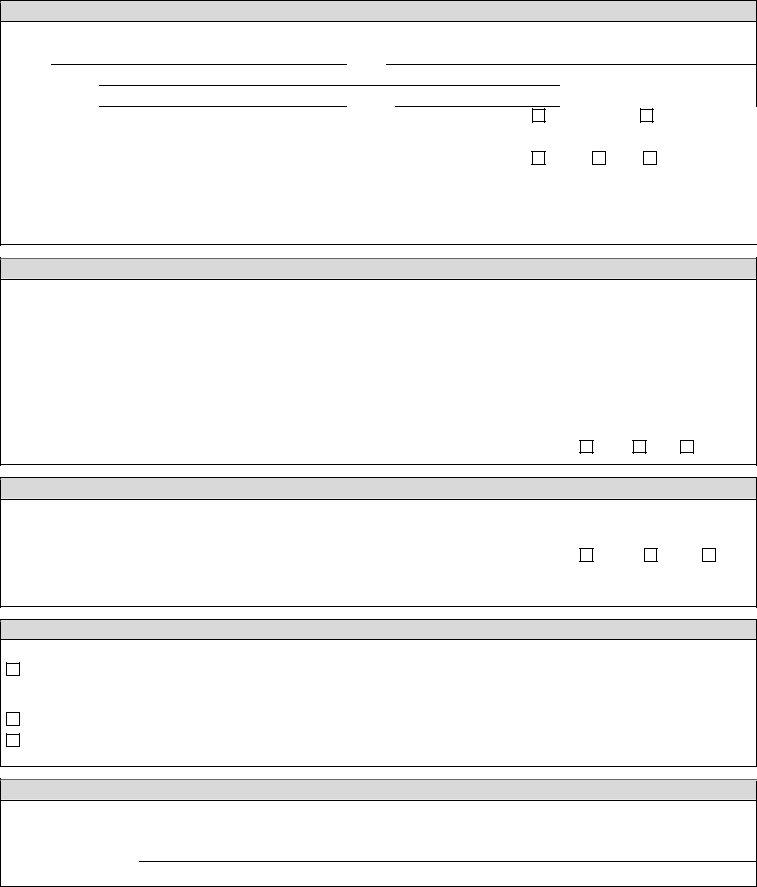The Ohio EPA 4309 form, a critical document issued by the State of Ohio Environmental Protection Agency, serves as a comprehensive tool for the application and approval process related to sanitary sewer system installations. This form, intricately designed to cover all facets of sanitary sewers’ construction and planning, is a testament to the agency's commitment to managing environmental considerations alongside developmental needs. The form captures essential details from the applicant, including the project's description—highlighting the location, size, and scope of the area to be served, and an assessment of future expansion possibilities. Furthermore, it delves into specifics such as pipe specifications, design flow, and the receiving wastewater treatment facility's capacity, aiming to ensure that the proposed system meets all regulatory and environmental standards. With sections dedicated to exploring the design of sewers, including their resistance to environmental challenges such as freezing, erosion, or impact at high velocities, the form provides a basis for evaluating the technical soundness of the proposed infrastructure. Additionally, it addresses crucial environmental protection measures, such as stream protection and the safeguarding of water supplies, reflecting the Ohio EPA’s overarching goal to preserve Ohio’s water resources while accommodating growth. By requiring detailed submissions regarding manhole design, installation and testing protocols, and stipulations for sewer use ordinance adherence, the document underscores the comprehensive approach needed to navigate the complexities of installing modern, safe, and environmentally sound sanitary sewer systems. As such, the Ohio EPA 4309 form stands as a pivotal document, meticulously guiding applicants through the rigorous process of securing permit-to-install approval, embodying the intersection of regulatory compliance, environmental stewardship, and infrastructural development.
| Question | Answer |
|---|---|
| Form Name | Ohio Form Epa 4309 |
| Form Length | 4 pages |
| Fillable? | No |
| Fillable fields | 0 |
| Avg. time to fill out | 1 min |
| Other names | PTIFormB1 ohio epa sanitary pti form |

State of Ohio Environmental Protection Agency |
|
|
Division of Surface Water |
Supplement to Form A – B1 |
|
Division of Environmental & Financial Assistance |
||
|
||
|
|
Sanitary Sewers
FOR AGENCY USE ONLY
Application Number:
Date Received: / |
/ |
|
|
Applicant:
Facility Owner:
Ultimate owner (if different):
Application/Plans Prepared by:
Project Name:
1. Project Description
a. Describe the location, size and current development of the area to be served. List street address, township, county, and include longitude and latitude coordinates in describing location.
b. What is the possibility that future sanitary sewer extensions will connect to the sanitary sewers which are the subject of this application?
c. Are there any pump stations included as part of this sewer construction? (If Yes, fill out attachment to Form B1)
d. Indicate type(s) of sewers proposed (check all that apply):
Conventional gravity |
Small diameter gravity (w/septic tanks) |
Vacuum |
Siphon |
Yes |
No |
Pressure (GP or STEP)
Force main (must include pump station)
2. Pipe Specifications
Please identify each type (as indicated in 1d above) and size of pipe included in this project.
Type |
Pipe |
Pipe |
Material * |
Joint* |
Bedding** |
Minimum |
|
Size |
Material |
Specification |
Specification |
Classification |
Slope |
||
|
Pipe
Length
Maximum
Manhole
Spacing
*List ASTM, AWWA, or ANSI specification number. For any specification that does not appear on Ohio EPA’s pipe specification list, the applicant shall submit the standard for approval with the
** 100 percent to pass
EPA 4309 (rev. 9/09) |
Form B1 |
Page 1 of 4 |

3. Design Flow in Proposed Sewer
Identify flows expected at
|
Average Daily Flow |
|
Peak Hourly Flow |
||
|
MGD |
|
|
MGD |
|
Design Flows (based on planned area served) |
|
MGD |
|
|
MGD |
|
|
|
|||
Hydraulic Capacity of Sewer |
|
MGD |
|
|
MGD |
|
|
|
|||
|
|
|
|
|
|
Assumptions used to calculate above flows: (check all that apply) |
|
|
|
Design |
|
|||||
Residential Population at: |
|
gal/home* |
|
homes |
|
|
|
homes |
|
|
|
|
|
|
|
|
|
|
|
|
|
Residential Population at: |
|
gal/cap/day |
|
people |
|
|
|
people |
|
|
|
|
|
|
|
|
|
|
|
|
|
|
MGD |
|
|
|
MGD |
|
||||
|
|
|
|
|
|
|
|
|
||
Computer Flow Modeling Results (attach explanation and data) |
|
|
|
|
|
|
|
|||
*120 gallon/bedroom in accordance w/ OAC
4. Receiving Wastewater Treatment Facility
a. What treatment facility will be receiving flow from these sewers?
Present treatment facility average daily flow |
|
MGD (based on |
/20 |
(month/year) ADF)* |
|
|
|
|
|
Proposed treatment facility average daily flow (based on present average daily flow plus all connections currently under construction or being designed)
Design average daily flow of the treatment facility |
MGD (based on |
b.Does the treatment facility have adequate capacity to treat anticipated flows from existing sewers plus the proposed sewers based on the sewer's design capacity?
If No, on a separate sheet, please describe the steps being taken to ensure that the treatment facility has adequate capacity. Include specific work items and schedules as appropriate.
MGD design year)
Yes No
c. Is there intent to expand the treatment facility to treat additional flows?
Yes
No
*Note: Flow data to be no older than one calendar year from date of PTI submission
5. Sewer Design
a. Are the sewers deep enough to serve all adjacent basements?
(refer to GLUMRB, Recommended Standards for Wastewater Facilities, 2004, Section 33.2)
If No, please explain how the basements will be served:
b. Are sewers at a sufficient depth to prevent freezing? (GLUMRB Section 33.2)
If No, please explain how freezing will be prevented:
c. Where small sewers join larger ones, have the inverts of the larger sewers been lowered sufficiently to maintain the same energy gradient? (GLUMRB Section 33.6)
d. Have provisions been made to protect sewers against displacement by erosion and impact at velocities over 15 fps? (GLUMRB Section 33.45)
e. Are sewers with slopes greater than 20 percent secured with concrete anchors (or equal), spaced as required? (GLUMRB Section 33.46)
f. Are there any overflows or bypasses upstream of the point of connection that may be impacted by the flows from the new sewer?
g. Are there any sanitary overflows or bypasses or combined sewer overflows downstream of the point of connection?
* (If Yes to f. or g., on a separate sheet provide a description of the exact location of any overflows or bypasses)
Yes No
Yes No
Yes No
Yes No
Yes No
Yes* No
Yes* No
N/A
N/A
N/A
h. Is the force main designed to withstand water hammer pressures and associated cyclic reversal of stresses that are expected with the cycling of wastewater pump stations?
(GLUMRB Section 49.4)
If No, please explain:
Yes
No
N/A
EPA 4309 (rev. 9/09) |
Form B1 |
Page 2 of 4 |

6. Stream Protection
a. Are there any stream crossings? (If Yes, fill out the stream evaluation addendum) |
|
Yes* |
No |
|
||
If Yes, |
|
|
|
|
|
|
1. |
How many crossings are made? (GLUMRB Section 36.14) |
Number of crossings: |
|
|
|
|
|
|
|
|
|
|
|
2. |
Are the crossings perpendicular to the stream? (GLUMRB Section 36.14) |
|
|
Yes |
No |
|
3. |
Are crossings to be made at previously disturbed areas? |
|
|
Yes |
No |
|
4. |
Is the streambed substrate composed primarily of solid rock, sand and gravel, or silt? |
Rock |
Sand/gravel |
Silt |
||
5. |
In areas of steep slope or unstable soils, are the sewers located on more level, terraced areas? |
Yes |
No |
N/A |
||
6. |
Are the sewers at a sufficient depth to protect the sewer line? (GLUMRB Section 36.11) |
|
Yes |
No |
N/A |
|
b. Do any sewers run parallel to any streams? |
|
|
Yes* |
No |
|
|
If Yes, |
|
|
|
|
|
|
1. |
Is there any woody vegetation along the stream banks? |
|
|
Yes |
No |
|
2. |
Are the sewers and construction easements located outside of the vegetated areas? |
|
Yes |
No |
N/A |
|
3. |
In areas of steep slope or unstable soils, are the sewers located on more level, terraced areas? |
Yes |
No |
N/A |
||
*If the response to either a. or b. is Yes, please provide the specific measures in the detail plans and specifications that will be used to ensure that damage to the stream corridor is minimized to the greatest extent possible and that the stream corridor is restored to original condition.
7. Manhole Design
a. Manhole type (precast
b. Material specification (ASTM):
c. Joint specification (ASTM):
d. Are watertight frames and covers used wherever manhole tops may be flooded by street runoff or high water?
If No, explain*:
e. Are manholes provided at the upstream end of each line? (GLUMRB Section 34.1)
If No, explain*:
Yes
Yes
No
No
N/A
f. Are manholes provided at all changes in size, grade, and alignment? (GLUMRB Section 34.1)
If No, explain*:
Yes
No
g. Are manholes provided at all sewer intersections? (GLUMRB Section 34.1)
If No, explain*:
Yes
No
h. Are drop manholes provided where the entrance sewer invert is 24 inches or more above the manhole invert?
If No, explain*:
i. Are inlet/outlet pipes connected with gasketed flexible watertight connections? (GLUMRB Section 34.6)
If No, explain*:
* Attach any additional sheets necessary for explanations.
Yes
Yes
No
No
N/A
8. Protection of Water Supplies
a. Are there any physical connections between the sewer and a public or private potable water supply system (including all appurtenances)?
b. Are any existing public waterworks units (for example public supply wells, water treatment facilities, storage facilities) within 200 feet of the proposed sewer or any private wells within
50 feet of the proposed sewer?
Yes
Yes
No
No
If Yes, specify the plan sheets on which the sources are shown: |
|
|
|
If Yes, will sewers be encased or constructed of watertight pipe? |
Encased |
Watertight |
|
c. Are the sewers at least 10 feet horizontally separated from water lines? (GLUMRB Section 38.31) |
Yes |
||
If No, please specify the plan sheets where these conditions are not met & describe the measures taken to ensure protection of the water system:
No
d. When crossing water mains, are the sewers at least 18 inches below water lines? |
Yes |
If No, please specify the plan sheets on which these conditions are not met and describe the measures taken to ensure protection of the water system:
No
EPA 4309 (rev. 9/09) |
Form B1 |
Page 3 of 4 |

9. Installation and Testing
a. Installation Inspector:
Name:Firm:
Street Address:
City:State:
b. What type of sewer leakage test will be used? (GLUMRB 33.9)
Page numbers in specifications for testing requirements of gravity and pressure sewers:
c. Is flexible pipe deflection testing specified? (GLUMRB 33.85)
Page numbers in specifications for testing requirements of flexible pipe:
d. What type of manhole testing will be used? (GLUMRB Section 34.7)
Page numbers in specifications for testing requirements of manholes:
Phone: ( ) |
- |
|||
|
Zip: |
|
|
|
|
|
|
||
|
|
|
|
|
Hydrostatic |
Air |
|||
|
|
|
|
|
Yes |
No |
N/A |
||
|
|
|
|
|
|
|
|
|
|
|
|
|
|
|
|
|
|
|
|
10. Sewer Use Ordinance
A statement that "Roof drains, foundation drains, and other clean water connections to the sanitary sewer system are prohibited" must be shown on the plans. Copies of the ordinances or regulations providing for the enforcement of this requirement must be on file with Ohio EPA.
a. An ordinance/regulation to this effect was adopted on: |
/ / |
(date). |
|
|
|
||
|
|
|
|
|
|
|
|
b. Enforcement of this ordinance/regulation is the responsibility of: |
|
|
|
|
|||
Name: |
|
|
|
|
|
||
|
|
|
|
|
|
|
|
Title: |
|
|
|
|
|
||
|
|
|
|
|
|||
c. It is the opinion of the engineer submitting these plans that adequate enforcement |
|
|
|
||||
of this ordinance/regulation is being properly carried out. |
|
Yes |
No |
Unknown |
|||
11. Authorities
a. Plans for the proposed installation of a county, village, or municipal sewer that is tributary to a sewage treatment plant with another political entity must be accompanied by written consent of both entities.
Is a written
Yes
No
N/A
12. Submittals:
This application must include the following unless otherwise directed by Ohio EPA:
Four copies of the detail plans including profile and plan views of all sewers (shown on the same sheet), existing (as applicable) and proposed pump station facilities, incorporating all of the details outlined in Section 20.1, 20.2 and 20.3 of Recommended Standards for Wastewater Facilities.
Two copies of complete technical specifications.
Two copies of the Application including Form A, pertinent B & C form(s), and antidegradation addendum (if applicable)
13. The foregoing data is a true statement of facts pertaining to this proposed sanitary sewer installation.
Date: |
/ |
/ |
Signed: |
|
P.E. |
|
|
|
|
|
|
Plans prepared by:
EPA 4309 (rev. 9/09) |
Form B1 |
Page 4 of 4 |